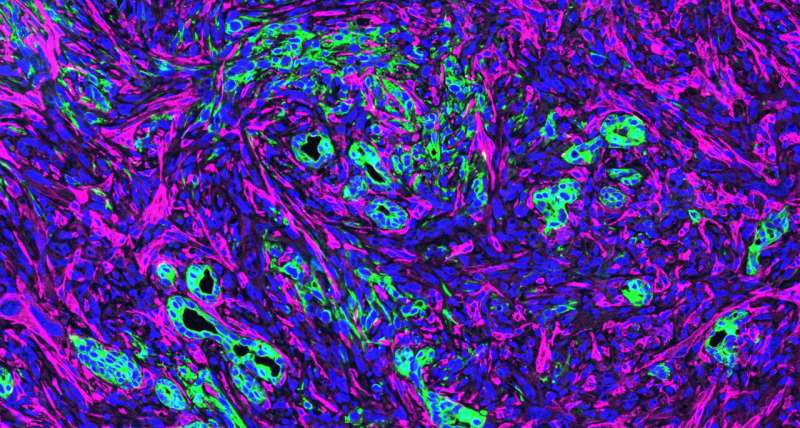This article has been reviewed according to Science X's editorial process and policies. Editors have highlighted the following attributes while ensuring the content's credibility:
fact-checked
peer-reviewed publication
trusted source
proofread
How drugs can target the thick 'scar tissue' of pancreatic cancer

Pancreatic cancer is one of the deadliest cancers—only about one in eight patients survives five years after diagnosis. Those dismal statistics are in part due to the thick, nearly impenetrable wall of fibrosis, or scar tissue, that surrounds most pancreatic tumors and makes it hard for drugs to access and destroy the cancer cells.
Now, researchers at the Salk Institute have discovered how a class of anti-cancer drugs called HDAC inhibitors can help treat pancreatic cancer by modulating the activation of fibroblasts—the cells that make up that wall of scar tissue.
The new research was published in Nature Communications on December 6, 2023.
"These drugs turn out to be hitting both the tumor itself as well as the fibrotic tissue around it. This could be a very effective way to treat pancreatic cancers, which have typically been very difficult to reach," says senior author Professor Ronald Evans, director of Salk's Gene Expression Laboratory and March of Dimes Chair in Molecular and Developmental Biology.
In response to a new pancreatic tumor, the pancreas typically activates fibroblasts—the connective cells that support the structure of most organs. When flipped from a resting state to an active state, fibroblasts build a thick layer of scar tissue around the cancer. While this normal protective mechanism can help wall off a cancer and prevent its spread, fibroblasts also produce signaling molecules that the tumor itself takes advantage of to grow.
"In the context of most pancreatic cancers, fibroblasts are acting as both good players and bad players," says Michael Downes, senior staff scientist and co-corresponding author on the paper. "It's a double-edged sword."
In the new research, the team probed the effect on fibroblasts of an experimental class of cancer drugs known as histone deacetylase (HDAC) inhibitors. HDACs alter the three-dimensional structure of DNA inside cells, making some stretches of DNA easier or harder for other molecules to access and read.
Targeting HDACs can therefore prevent cells from making large changes to their behavior, such as the out-of-control growth of cancer cells. But how the drugs work on all cell types is not well understood.
In experiments on isolated cells, the researchers discovered that HDAC inhibitors prevented fibroblasts from becoming activated and tumor supportive.
"Using HDAC inhibitors actually did two things—it both turned down the growth signals from the fibroblasts to the cancer cells and it reduced the actual activation and accumulation of the fibroblasts," says Gaoyang Liang, first author and research associate in Evans' lab.
In mice, the researchers found that one experimental HDAC inhibitor, entinostat, both reduced the activation of fibroblasts around pancreatic tumors and slowed tumor growth. When the researchers analyzed data from humans with pancreatic cancer, they discovered something similar: the higher the levels of HDAC1 in the fibrotic tissue around a patient's tumor, the worse their outcome.
"This is in agreement with what we saw in cells and in mice," says Downes. "If you have more HDAC activities in the fibroblasts, you have a worse outcome. On the other hand, if you inhibit the HDACs, you have a better outcome."
Since HDAC inhibitors work by preventing cells from activating certain genetic programs, the researchers wanted to know which stretches of DNA impacted by the drugs were most relevant for fibroblast activation. They identified several genes that HDAC inhibitors prevent from being expressed—suggesting that new drugs could target those genes to keep fibroblasts from becoming activated and promoting cancer growth and fibrosis.
"There have been some questions in the past about whether targeting fibroblasts is a good thing or a bad thing in pancreatic cancers, because people have shown that if you get rid of fibroblasts altogether it actually makes the cancers more aggressive," says Annette Atkins, co-author of the study and senior research scientist in Evans' lab. "But what our results suggest is that we don't have to get rid of them; just limiting their activation is beneficial."
More work is needed to pinpoint how to best deliver HDAC inhibitors to the dense fibrotic tissue around pancreatic tumors, as well as how they might be most effectively combined with other cancer treatments.
More information: Gaoyang Liang et al, Inhibiting stromal class I HDACs curbs pancreatic cancer progression, Nature Communications (2023). DOI: 10.1038/s41467-023-42178-6



















